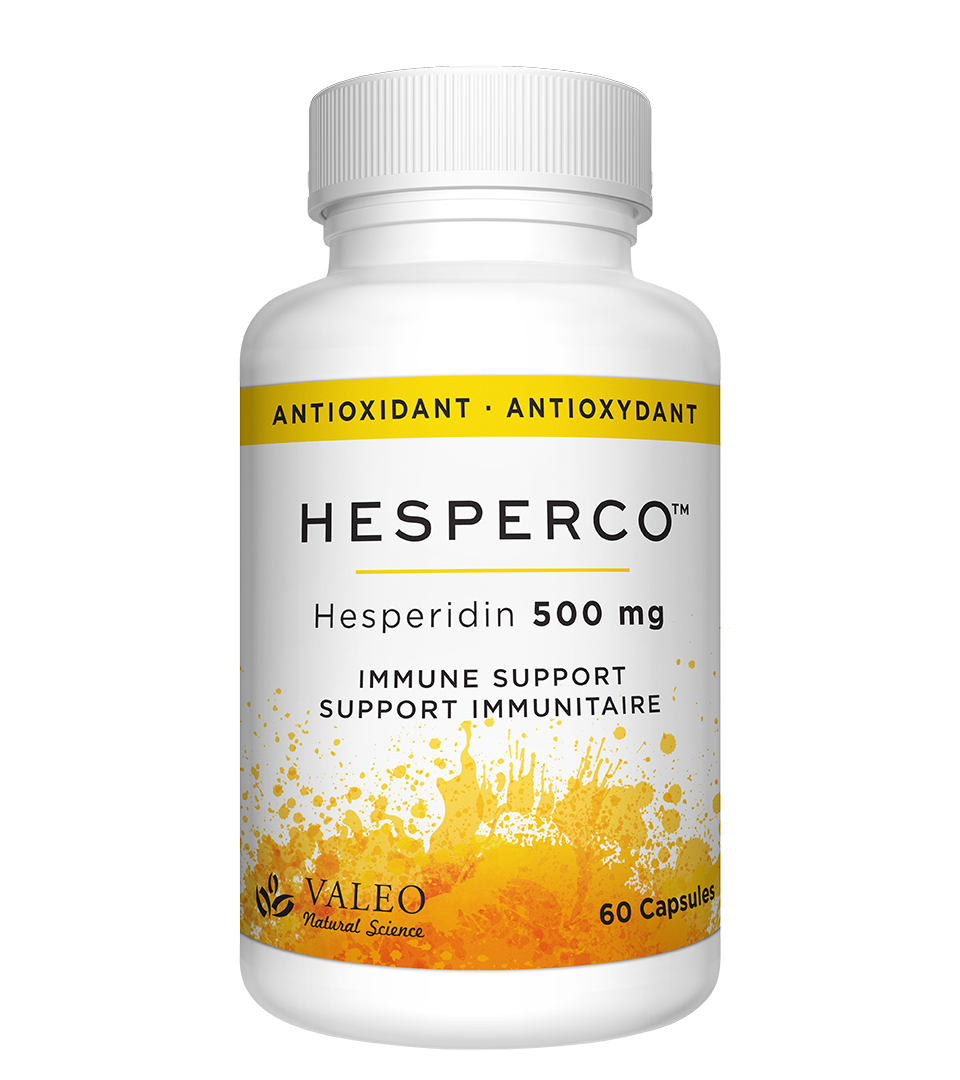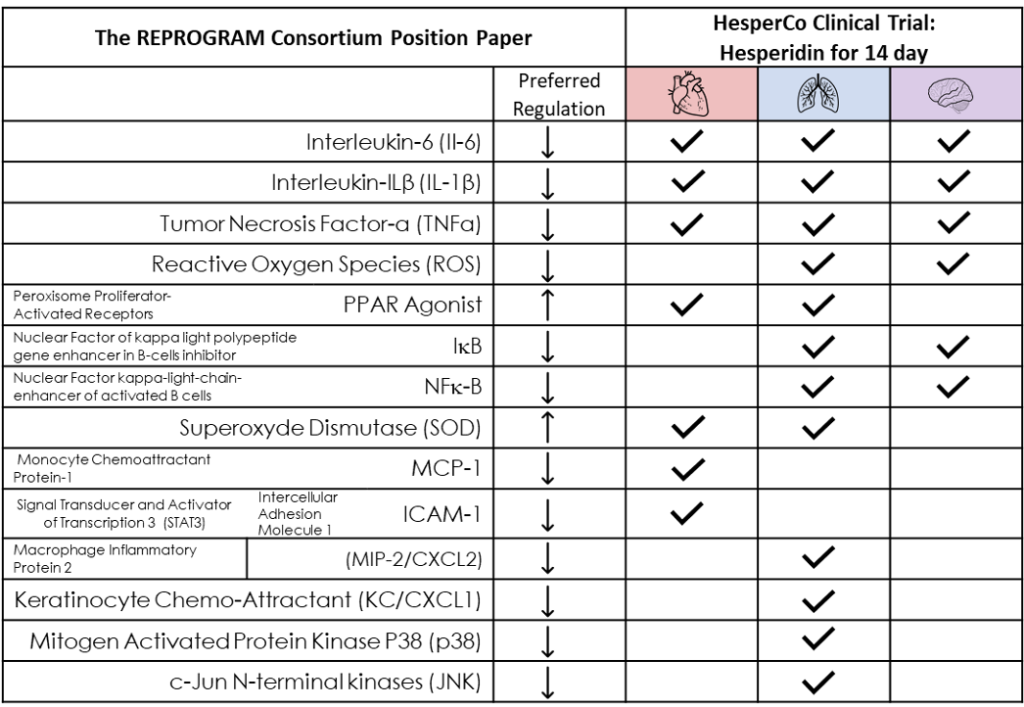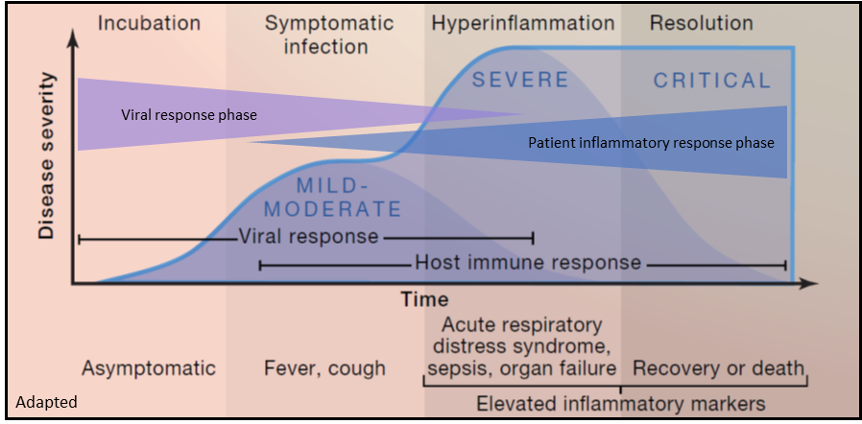The Hesperidin Study
The Hesperidin Study
A randomized, double-blind, placebo-controlled study of hesperidin therapy on COVID-19 symptoms
Hesperidin to reduce the severity of illness and requirement for hospitalization
See highlights of the clinical trial results in the news release
A paper entitled: “Fourteen-days Evolution of COVID-19 Symptoms During the Third Wave in Non-vaccinated Subjects and Effects of Hesperidin Therapy: A Randomized, double-blinded, placebo-controlled study” has been submitted for publication and a preview is available here.
Hesperidin & the modulation of inflammation and cytokine storm
The REPROGRAM Consortium Position Paper was prepared by an international not-for-profit think-tank for global pandemic preparedness and action.
The authors list what ideally a drug or a cocktail of drugs should be regulating to prevent or treat the exuberant inflammatory response – cytokine storm in COVID-19:
- ↓ means down regulate or reduce
- ↑ means upregulate or increase
Note how hesperidin has been reported to regulate these cytokines in experiments where severe inflammation was induced to affect the heart, lungs and brain.
For individuals who become symptomatic, the incubation period, the time from exposure to symptom onset, is 4–5 days on average with the most common symptoms including fever and cough.
Mild cases are likely characterized by a robust immune response, resulting in viral clearance.
For a minority of subjects, the disease worsens approximately 5–10 days after symptom onset, resulting in complications such as acute respiratory distress syndrome (ARDS) and other organ failure. In such severe cases, there is likely an initial delay in the antiviral response and subsequently increased production of inflammatory cytokines (cytokine storm syndrome).
The Hesperidin Study
A randomized, double-blind, placebo-controlled study of hesperidin therapy on COVID-19 symptoms
Hesperidin to reduce the severity of illness and requirement for hospitalization
Scientific Rational for the use of Hesperidin in COVID-19 treatment:
- The pandemic is a noncontrolled infection/immunization/vaccination on a global scale with SARS-CoV-2 as the immunogen
- As such the primary immune response plays a key role but more precisely the lag time within the primary immune response
- Before and during the primary immune response, SARS-CoV-2 can proliferate, disseminate and cause severe inflammation or cytokine storm
- From an exhaustive review of the scientific literature related to SARS of 2002-2004 and the recent abundance of literature published on SARS-COV-2 and COVID-19, scientific assumptions are:
- Hesperidin could address COVID-19 by these mechanisms:
- Reported/anticipated to reduce viral load
- Reported/anticipated to modulate inflammatory mediators
- Hesperidin could address COVID-19 by these mechanisms:
Objectives:
- Reduction of the severity of illness
- Reduction of the requirement for hospitalization
Compound to be studied in the Hesperidin Clinical Trial:
- Hesperidin
Quality attribute reported in the scientific literature for hesperidin:
2 independent mechanisms of action:
- Reported/anticipated to prevent entry and replication of SARS-COV-2
- Reported/anticipated to modulate inflammatory mediators as evidenced in various animal models:
- Myocardial infarction, ventilator-induced acute lung injury, neuronal apoptosis, cognitive impairment and other inflammatory models.
Length of the protocol:
- 14 days
Hesperidin Clinical Trial: Establishing the scientific rational:
- Presented in 2 downloadable PowerPoint presentations: short (highlights) and long (comprehensive) versions (PDF) or viewed in narrative videos.
- The pandemic is a noncontrolled infection / immunization / vaccination on a global scale with SARS-CoV-2 as the immunogen
- As such the primary immune response plays a key role but more precisely the lag time within the primary immune response
- Before and during the primary immune response, SARS-CoV-2 can proliferate, disseminate and cause severe inflammation or cytokine storm
- From an exhaustive review of the scientific literature related to SARS of 2002-2004 and the recent abundance of literature published on SARS-COV-2 and COVID-19, scientific assumptions are:
- Hesperidin could address COVID-19 by these mechanisms:
- Reported/anticipated to reduce viral load
- Reported/anticipated to modulate inflammatory mediators
- Reduction of the severity of illness
- Reduction of the requirement for hospitalization
2 independent mechanisms of action:
- Reported/anticipated to prevent entry and replication of SARS-COV-2
- Reported/anticipated to modulate inflammatory mediators as evidenced in various animal models:
- Myocardial infarction, ventilator-induced acute lung injury, neuronal apoptosis, cognitive impairment and other inflammatory models.
- 14 days
- Presented in 2 downloadable PowerPoint presentations: short (highlights) and long (comprehensive) versions (PDF) or viewed in narrative videos.
Learn more
- Reported/anticipated to prevent entry and replication of SARS-COV-2
- Reported/anticipated to modulate inflammatory mediators as evidenced in various animal models:
- Myocardial infarction, ventilator-induced acute lung injury, neuronal apoptosis, cognitive impairment and other inflammatory models.

Other Development Activities
Dermatology
Actinic Keratosis
Basal and Squamous Cell Carcinoma Melanoma
We also work on
Dermatology
Actinic Keratosis
Basal and Squamous Cell Carcinoma Melanoma



